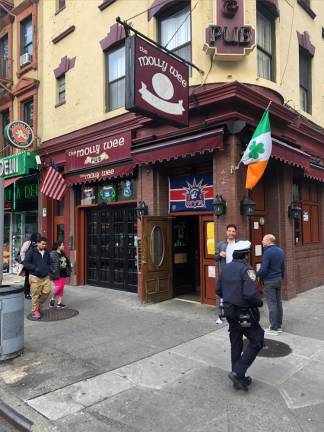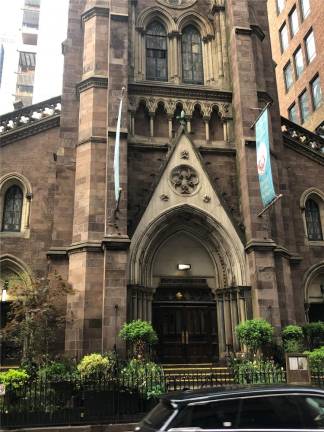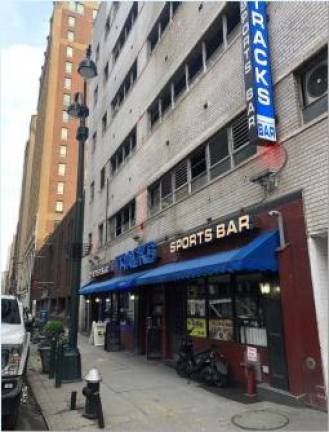Activist Demands Big 3 RRs Hold Public Review to Avoid Demolishing Biz Near Penn



The railroads that operate at Penn Station should conduct an independent, and public, review of whether they really need to tear down the block to the south of the present station to accommodate the increased train traffic they forecast will come through the new tunnel being built under the Hudson River, a key advocate demanded.
“This analysis should take place in the very near term and from our standpoint should have happened a long time ago,” wrote Samuel Turvey, chair of the advocacy group, ReThinkNYC.
“We would have thought maximizing capacity at Penn Station would have been one of the earliest questions to resolve, not one to be determined at an unspecified later date.”
Turvey made his plea in a letter to Governor Kathy Hochul and top officials of the three railroads who use Penn Station–Amtrak, New Jersey Transit and the MTA (which runs the Long Island Rail Road and MetroNorth).
The letter highlighted the inverted order in which decisions have been made around improving Penn Station, generally thought of as one of the worst rail stations in North America, as well as the busiest.
Officials are well along in drafting, and debating, plans for a renovated train hall to bring passengers more light and air as they await their trains. And at the same time work has begin on the Gateway project to build a new rail tunnel under the Hudson to supplement the current tunnel built in 1910 by the now long defunct Pennsylvania Railroad.
But what has not yet been resolved is how many more trains will, in the end, run through the new tunnel and into this rebuilt Penn Station, where exactly they will go and how will they operate.
“It’s still early in the process and we are in the beginning stages of engineering and planning,” said Amtrak spokesman Jason Abrams. “We are working through design and preparing for a public, and robust, engagement process with our partners. We should have details on next steps and timing soon.”
The railroads have said that to accommodate the increased train service Penn Station will need to be expanded. The most widely discussed plan involves demolishing the block to the south of the station, often referred to by its tax roll designation, block 780.
But residents of the block, which includes apartment buildings, parking garages, restaurants and bars have mounted a spirited resistance, joined by advocates including Turvey.
He has emerged as a leading proponent of a different approach, which would be to completely reorganize how the railroads operate in and out of the station.
While Amtrak owns the station, most of the rail traffic is by its tenants, New Jersey Transit and The Long Island Rail Road.
Amtrak runs its trains through Penn Station, dropping passengers and picking them up at the same time.
But the commuter railroads terminate their runs at the station and then later return from where they came. It would be far more efficient, Turvey and others argue, to run the commuter trains through Penn Station to other destinations beyond the station. Long Island Railroad trains would continue on to New Jersey and Jersey Transit trains could carry passengers to Queens and Long Island.
This would be a boon for the economy and alleviate the need to expand Penn Station, Turvey and the other advocates argue.
But the railroads have been skeptical. “Amtrak and other Railroads have repeatedly questioned the ability of ReThinkNYC’s through running and other similar proposals to provide enough capacity to meet future ridership needs at Penn Station,” Turvey wrote. “While this maxim has been often repeated by the Railroads and their advocates for years, we have yet to see bona fide data or calculations supporting these statements.”
Amtrak, which is in charge of the question of expanding Penn Station, has said it is examining through running as part of an environmental review. “Amtrak and our partners are giving careful consideration to the question of through running operations at Penn Station, but see many challenges with relying exclusively on through running as a solution to doubling Northeast Corridor capacity,” an Amtrak Vice President, Jeannie Kwon, said in an interview with The Architects Newspaper earlier this month.
While Turvey characterized this statement as “daylight for through running,” he pressed in his letter for a far more formal and detailed process of review.
“The Railroads cite these capacity considerations as the justification for their need for a profoundly expensive and destructive expansion of Penn Station to the south and also as a premise to dismiss converting Penn station commuter rail to through running, Turvey wrote. “Again, they have provided no bona fide data to back this claim.”
To create trust in the outcome, Turvey urged the railroads to conduct a review, using modeling software and supervised by an independent firm.
“A neutral party should perform the modeling, with full input from the Railroads and the public representatives. Proponents of different proposals should be part of the process and able to fully explain their operating models in creating the modeling of their respective proposals.”
The modeling software Turvey described is widely used by Amtrak and the commuter railroads to design their schedules and weigh needs for new infrastructure.
Through running would require changes in track electrification and possibly rolling stock, so the commuter railroads could operate on each others tracks. In addition, many platforms at Penn Station would have to be widened and lengthened to accommodate more passengers, as they both get on and off the same trains.
Turvey pointedly urged the railroads to give a “meaningful role” in the review to “senior transit executives and personnel with actual experience in designing, creating and implementing through running commuter operations.”
He did not mention any names, but seemed to be referring to Andy Byford, who helped build the new Elizabeth Line, from one side of London to the other, and was formerly the head of the New York City Transit Authority. Byford is now in charge of high-speed rail for Amtrak, but has been held at arms length from Penn Station discussions after he publicly endorsed through running for the New York Commuter lines.
Another advocate of through running, Layla Law-Gisiko, President of the City Club, said she agreed with the need for a full review and added that it should include an examination of the potential economic benefits to the region of improved commuter rail service. Major cities where commuter rail service runs through the central city, rather than terminating there, include Paris, London and Philadelphia.
Turvey noted that the Federal Railroad Administration, which holds the purse strings on federal rail projects, gives clear direction in its manual for transportation plans, which states:
“Each station track configuration should provide for the through movement of trains along the corridor without having to reverse the train’s direction at any time. Through stations are almost always preferable to stub end terminals, both at the end points and intermediate points in a corridor.”